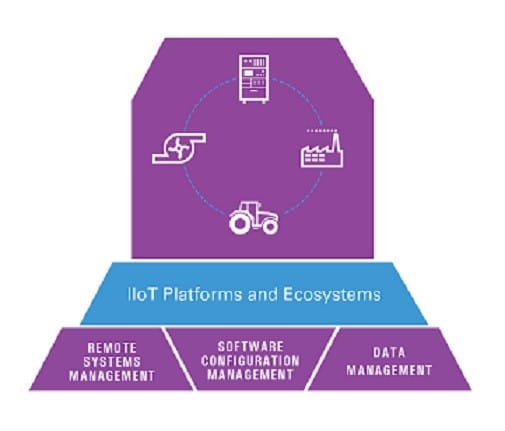The Industrial Internet of Things (IIoT) has quickly evolved from concepts and pilot projects to fleet-wide deployments with impressive returns. These returns are based largely on the actionable, data-driven insights that have equipped forward-looking companies, such as Jaguar Land Rover, China Steel, and Duke Energy, to maximize uptime, boost performance, and drive future product innovation. Industry is evolving to become smarter and more connected. Late adopters of the IIoT risk losing market share and incurring unnecessary costs by not keeping up with the pace of innovation. In fact, “95 percent of business leaders expect their company to use the IIoT within the next three years,” according to Accenture’s Connected Business Transformation report from March 2017.
With today’s edge node hardware and analytics software, it’s fairly straightforward to extract business benefits from small-scale IIoT pilots for predictive maintenance and connected smart machine control. Technologies are readily available today to enable a growing volume of connected systems and uncover engineering and operational intelligence management challenges that will define the continuing evolution of the IIoT. Attention and investment are now shifting toward the next challenge: scaling and managing large IIoT deployments, including remote systems management, software configuration management, and data management.
1. Remote Systems Management
With reduced operational technology costs, systems that monitor and control critical assets have become prevalent. Asset and maintenance managers now face the challenge of implementing cost-effective strategies to manage those operational technologies and minimize asset downtime. Companies can harness the flexibility cloud-hosted technologies offer to implement remote system management solutions that provide useful insights into the state of multiple connected systems.
Successful remote system management solutions will need to address system aspects such as provisioning, configuration, diagnostics, and edge device administration. Remote system management capabilities often include monitoring system parameters, such as memory and CPU usage, networking, and I/O statistics, at the task or process level to help minimize the impact of downtime due to software bugs and discover potential security breaches.
2. Software Configuration Management
The IIoT market is setting high expectations for continuous delivery and improvement. Increasing pressure to get to market quickly demands flexibility from software to fix bugs, modify functionality, and respond to security vulnerabilities. Failing to implement effective software management strategies can lead to systems running outdated software, which can impact asset performance, security, and reliability. IIoT companies can implement proven frameworks and best practices to avoid the costs and inefficiencies of manual software distribution.
Effective software configuration management strategies in industrial settings will operate in highly dynamic, heterogeneous environments where system availability and network stability are variables. A high mix of systems from multiple vendors operating at different levels of the IIoT network will require technologies capable of tracking and controlling granular software changes at the application and firmware levels of each system. Going forward, companies will need to transition to platforms that incorporate software configuration management best practices to navigate the often-blurry boundaries between operational technology (OT) and mainstream IT solutions without impacting the business.
3. Data Management
IIoT systems can generate massive amounts of data in the order of terabytes and potentially exabytes. Managing this amount of data to obtain actionable insights is a vector of differentiation that companies must address to understand their business and implement improvements. Valuable information is hidden in the oceans of data produced by IIoT systems, and these insights can be unlocked using intelligent and advanced signal processing. As data management technologies become more accessible, companies have a range of options to manage their data and obtain insights across all levels of the organization.
Data management strategies need to include analysis features that operate at both the edge and enterprise levels. According to “IDC FutureScape: Worldwide Internet of Things 2017 Predictions,” by 2019, at least 40 percent of IoT-created data will be stored, processed, analyzed, and acted upon at the edge. An effective data management solution needs to incorporate data from multiple distributed sources and produce different levels of insights to get the right information in front of the right people so they can translate raw data into informed decisions.
The Time Is Now: The Power of Platforms
Building IIoT solutions today represents an opportunity to develop a competitive edge and avoid getting left behind as the market continues to embrace available solutions. Companies across all industries are adopting a new breed of disruptive platforms and ecosystems that will transform businesses into engines of innovation and growth by exploiting intelligent technologies such as sensor-driven computing, industrial analytics, and intelligent machine applications. With IIoT technologies, we can harness the benefits of these state-of-the-art platforms to ultimately reduce maintenance costs and improve asset utilization.
Carlos Pazos, Senior Product Marketing Manager, Platform Software, National Instruments














